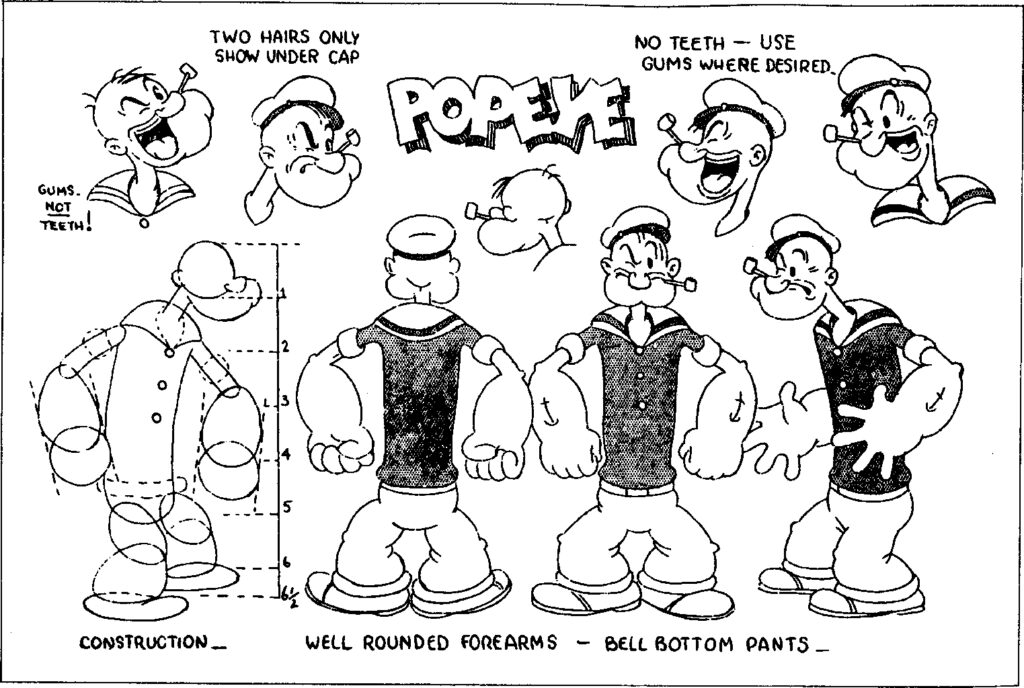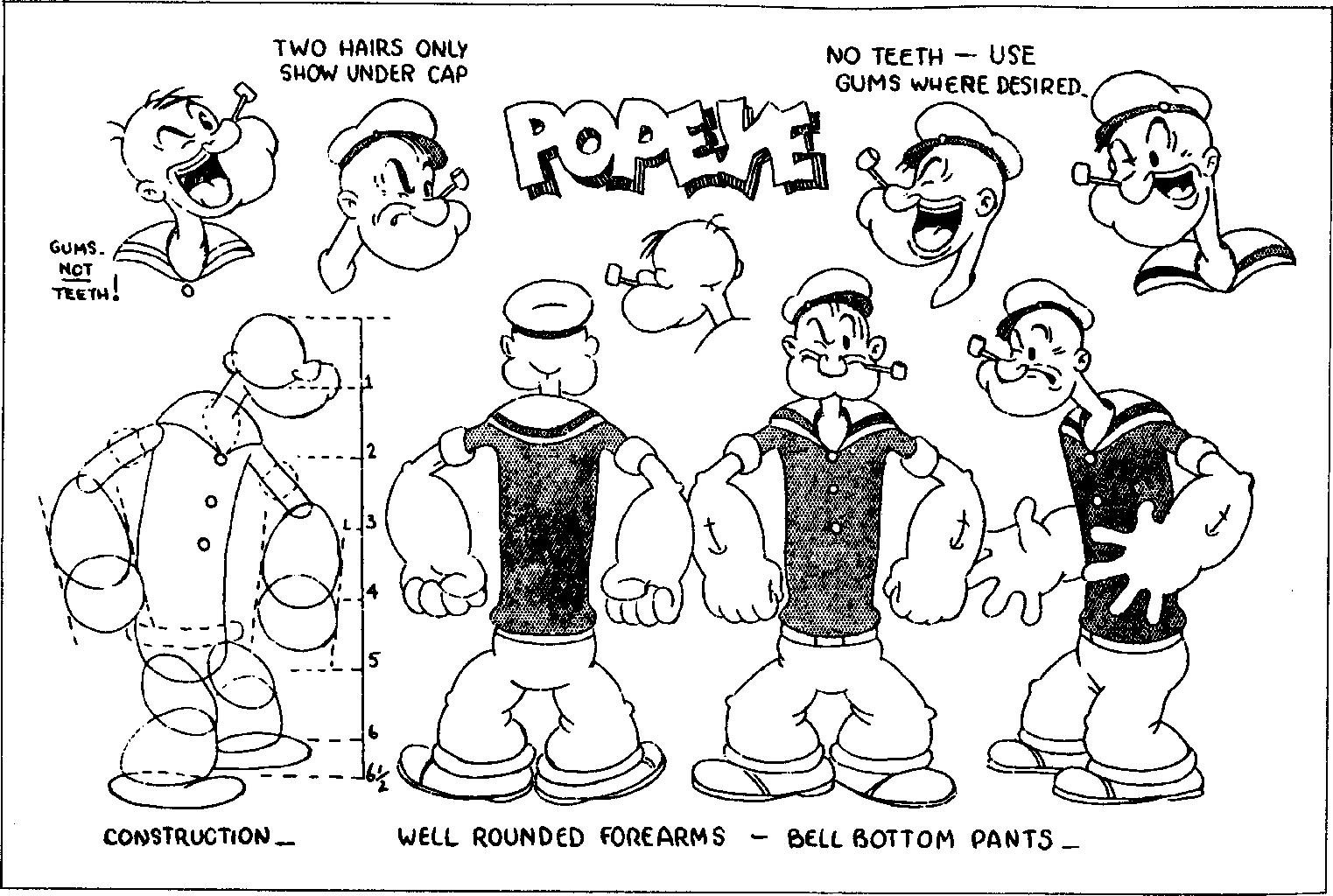
Popeye the Sailor Man: An Enduring Cartoon Character Icon
Popeye, the one-eyed, spinach-loving sailor, is more than just a cartoon character; he’s a cultural icon. Created by Elzie Crisler Segar in 1929, Popeye first appeared in the *Thimble Theatre* comic strip, which had initially focused on the adventures of Olive Oyl’s family. However, Popeye’s immediate popularity quickly shifted the strip’s focus, launching him into a decades-long career across comics, animated shorts, and even a live-action film. This article explores the origins, evolution, and enduring appeal of this beloved cartoon character.
The Birth of a Legend
Elzie Crisler Segar, better known as E.C. Segar, introduced Popeye as a minor character in his *Thimble Theatre* comic strip on January 17, 1929. Initially, the strip revolved around Olive Oyl, her brother Castor Oyl, and Castor’s various schemes. Popeye was brought in as a sailor whom they hired to pilot their ship for a treasure hunt. His gruff demeanor and incredible strength, even without spinach, immediately captivated readers. Segar reportedly based Popeye on a local sailor from his hometown of Chester, Illinois, named Frank “Rocky” Fiegel. Fiegel, like Popeye, was known for his fighting prowess and pipe-smoking habit.
Within a year, Popeye had become the star of *Thimble Theatre*, and the strip was soon renamed *Popeye*. Segar’s storytelling, combined with Popeye’s unique charm, solidified the character’s place in popular culture. His catchphrases, like “I yam what I yam,” became instantly recognizable and quotable.
Animated Stardom
Popeye’s transition to animation in 1933 cemented his status as a household name. Max and Dave Fleischer, pioneers in animation, brought Popeye to life in a series of theatrical shorts produced by Paramount Pictures. These cartoons amplified Popeye’s comedic elements and action-packed adventures. The Fleischer brothers’ distinctive animation style, characterized by rubber-hose animation and surreal backgrounds, perfectly complemented Popeye’s larger-than-life personality.
The animated shorts introduced several iconic elements that are now synonymous with Popeye. The most notable is, of course, his spinach addiction. In the cartoons, Popeye gains superhuman strength after consuming a can of spinach, allowing him to overcome seemingly insurmountable obstacles and defeat his nemesis, Bluto (also known as Brutus in some iterations). This recurring gag not only provided comedic relief but also subtly promoted the nutritional benefits of spinach to a generation of children. [See also: The History of Animation]
Furthermore, the Fleischer cartoons established the classic love triangle between Popeye, Olive Oyl, and Bluto. Bluto’s relentless attempts to woo Olive away from Popeye fueled countless conflicts, which invariably ended with Popeye consuming spinach and delivering a knockout punch. The dynamic between these three characters became a cornerstone of the Popeye franchise.
Evolution Through the Years
After the Fleischers, Famous Studios (later Paramount Cartoon Studios) took over the production of Popeye cartoons in the 1940s. While these cartoons maintained Popeye’s core characteristics, they often lacked the artistic flair and surreal humor of the Fleischer era. Despite this shift in style, Popeye remained a popular character, continuing to entertain audiences throughout the 1950s.
In the 1960s, Popeye experienced a resurgence in popularity thanks to a new series of cartoons produced by King Features Syndicate. These cartoons were made for television and featured a simplified animation style. Although they were less visually impressive than the earlier shorts, they introduced Popeye to a new generation of viewers. Jack Mercer, who had voiced Popeye since the 1930s, continued to provide the character’s distinctive voice, ensuring continuity across different eras.
The 1980s saw the release of a live-action Popeye film directed by Robert Altman and starring Robin Williams as the titular character. While the film received mixed reviews, it remains a cult classic for its unique interpretation of the Popeye universe. The film’s set design, which recreated the fictional town of Sweethaven, was particularly praised for its attention to detail. [See also: Robin Williams’ Impact on Comedy]
The Enduring Appeal of Popeye
What explains Popeye’s enduring appeal? Several factors contribute to his lasting popularity. First, Popeye is a relatable character. Despite his superhuman strength when powered by spinach, he is portrayed as an underdog. He’s a working-class hero who faces challenges with determination and resilience. His “I yam what I yam” philosophy resonates with audiences who appreciate his authenticity and refusal to conform.
Second, the humor in Popeye cartoons is timeless. The slapstick comedy, combined with witty dialogue, appeals to viewers of all ages. The dynamic between Popeye, Olive Oyl, and Bluto provides a consistent source of entertainment, as their interactions are often exaggerated and absurd. The visual gags, such as Popeye’s bulging muscles after consuming spinach, are inherently funny and memorable.
Third, Popeye’s positive message about the benefits of healthy eating has had a lasting impact. While the idea of gaining superhuman strength from spinach is, of course, fantastical, the cartoons subtly encouraged children to consume vegetables. Popeye became an unlikely advocate for healthy eating habits, influencing generations of viewers to make better dietary choices.
Finally, Popeye represents a simpler time. The cartoons evoke a sense of nostalgia for a bygone era, when entertainment was less complex and more wholesome. Popeye’s adventures are straightforward and uncomplicated, providing a welcome escape from the complexities of modern life.
Popeye’s Legacy
Popeye‘s influence extends beyond entertainment. He has become a symbol of strength, resilience, and individuality. His image has been used in advertising campaigns, public service announcements, and even political cartoons. Popeye has transcended his origins as a comic strip character to become a cultural touchstone.
Popeye continues to be relevant in the 21st century. His cartoons are still broadcast on television, and his image appears on merchandise ranging from clothing to collectibles. New generations of children are being introduced to Popeye through streaming services and online platforms, ensuring that his legacy will endure for years to come.
In conclusion, Popeye the Sailor Man is more than just a cartoon character; he is an enduring icon whose appeal transcends generations. From his humble beginnings in the *Thimble Theatre* comic strip to his animated stardom and beyond, Popeye has captivated audiences with his unique charm, humor, and positive message. His legacy as a symbol of strength, resilience, and individuality is secure, ensuring that he will continue to be remembered and loved for many years to come.
The Unforgettable Characters of Popeye’s World
Beyond Popeye himself, the supporting characters in his world contribute significantly to the overall charm and appeal of the cartoons and comics. Olive Oyl, Bluto, Wimpy, and Swee’Pea are all integral parts of the Popeye universe, each with their own distinct personalities and quirks.
Olive Oyl
Olive Oyl is Popeye’s long-time girlfriend, known for her tall, slender frame, distinctive hairstyle, and often-distressed demeanor. She frequently finds herself in trouble, requiring Popeye’s intervention. While she can be somewhat ditzy and indecisive, she is also portrayed as kind-hearted and loyal to Popeye. Her constant vacillation between Popeye and Bluto provides much of the comedic tension in the cartoons.
Bluto (or Brutus)
Bluto, also known as Brutus in some versions, is Popeye’s primary antagonist. He is a large, muscular brute who constantly tries to woo Olive Oyl away from Popeye. Bluto’s aggressive tactics and relentless pursuit of Olive often lead to physical altercations with Popeye, culminating in Popeye’s spinach-fueled victories. Despite his villainous nature, Bluto is often portrayed in a comedic light, making him a lovable rogue.
Wimpy
Wimpy is a lovable mooch known for his insatiable appetite for hamburgers. His famous catchphrase, “I’ll gladly pay you Tuesday for a hamburger today,” perfectly encapsulates his character. Wimpy is often depicted as a lazy and opportunistic character, always looking for a free meal. Despite his flaws, he is a loyal friend to Popeye and provides comic relief with his eccentric behavior.
Swee’Pea
Swee’Pea is an abandoned infant whom Popeye adopts and cares for. He is often the target of kidnappings and other mishaps, requiring Popeye to come to his rescue. Swee’Pea’s innocence and vulnerability add a touch of sentimentality to the Popeye cartoons, highlighting Popeye’s caring side.
These characters, along with Popeye, create a vibrant and memorable cast that contributes to the enduring appeal of the Popeye franchise. Their interactions and relationships provide a rich tapestry of humor, action, and heart, ensuring that Popeye remains a beloved cartoon character for generations to come. [See also: The Evolution of Cartoon Characters]

